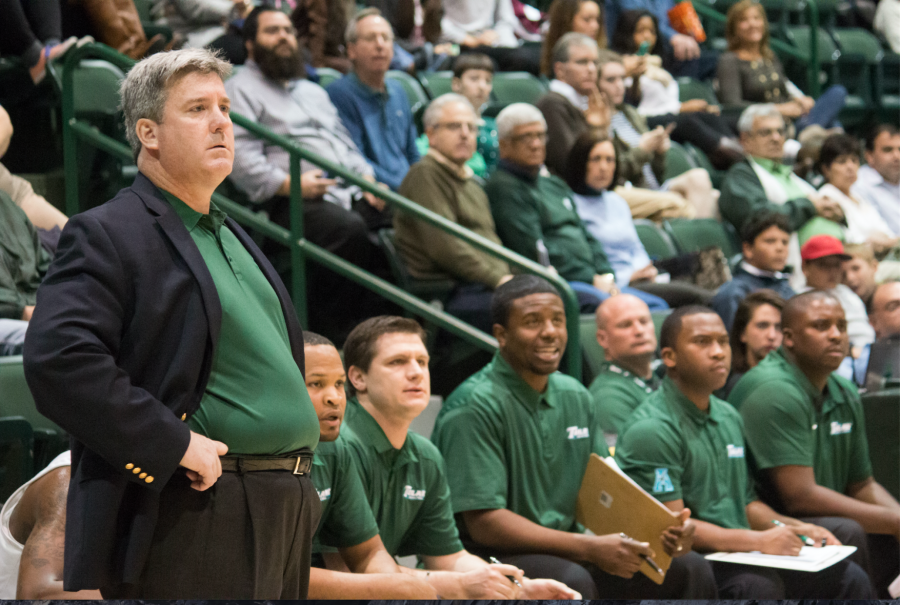Opinion: Mystery surrounds Conroy’s newest convoy
Tulane head coach Ed Conroy watches over the team’s performance along with the rest of the coaching staff in Devlin Fieldhouse.
October 7, 2015
Perfect timing, patience and a bit of fortune help build the identity of a sports program. For Tulane men’s hoops, it’s back to square one.
Head coach Ed Conroy lost seven players last season and will replace three previous starters in Jonathan Stark, now at Murray State, Jay Hook (graduated, now playing in Argentina) and Tre Drye (graduated) with relatively unproven freshman players, making this crop of ballers an intriguing bunch.
Of the remaining players returning from the previous season, senior guard Louis Dabney, sophomore forward Dylan Osetkowski and junior guard Kajon Mack top the minute totals, playing 32, 22.2 and 14.2 minutes per game, respectively.
Besides junior center Ryan Smith, who has had conditioning issues that have prevented him from staying on the floor in long spurts, the Green Wave plans on integrating seven new players, now that the sixth-best overall prospect Kipper Nichols recently decided to rethink his enrollment.
Dickson gave Conroy a chance to build a competitor but Tulane hasn’t been to the NCAA Tournament since 1995 and it looks like fans will have to wait a bit more as Conroy now has to rebuild the foundation of the program.
The recent core had difficulty creating offensive opportunities both in the post and on the wings which put a ton of pressure on the guards. Conroy previously had Stark primarily handle the ball on offense, and he would fly by defenders, take a running flick shot over taller defenders to the hoop, or swing it to the sharp-shooting Hook for a triple.
Though Conroy largely entrusted the keys to the offense to Stark, Dabney was the clear second option. But without a third creator, Stark and Dabney were held to below 40 percent shooting on the season, both lows for the previous season.
Osetkowski came on strong the second half of the season, bullying opponents in the high post and becoming vital in penetrating opponents’ zone defenses, while Smith struggled creating his own offensive opportunities.
Unless Smith takes a giant leap, Conroy could pair Osetkowski with Washington transfer senior Jernard Jarreau, with a 6-foot, 10-inch build and 235 pounds of muscle to defend taller bigs, and move the Big-O to the four slot to run town on smaller, shorter defenders. Not only can Osetkowski put the ball on the floor but he’s a willing and very able passer who can also set tough screens to free up shooters.
Though Osetkowski can bang down low, he seemed more comfortable floating defensively against less physical players, leaving the shorter Drye to pick up the bigger, taller centers, which gave the Wave trouble defending at the rim.
With Drye’s departure, the Wave will lean on a combination of Osetkowski, Smith, Jarreau and freshmen Taron Oliver and Blake Paul. Oliver and Paul will battle for playing time, and Conroy will probably play the better defender and better pairing with Osetkowski.
A new squad of guards should clog the backcourt rotation, as freshmen Kain Harris, Von Julien and Melvin Frazier join now eligible LSU transfer junior guard Malik Morgan, Dabney and Mack in the most athletically inclined group Conroy has seen since arriving at Tulane.
If he can figure out a cohesive rotation that showcases the plethora of guards and find a good frontcourt match for Osetkowski, this offense could have new life, with gifted, agile scorers that create for both themselves and others.
But for now, Tulane men’s basketball epitomizes the wait-and-see approach, as we wait to see how Conroy best sets the foundation of this new era.























Leave a Comment